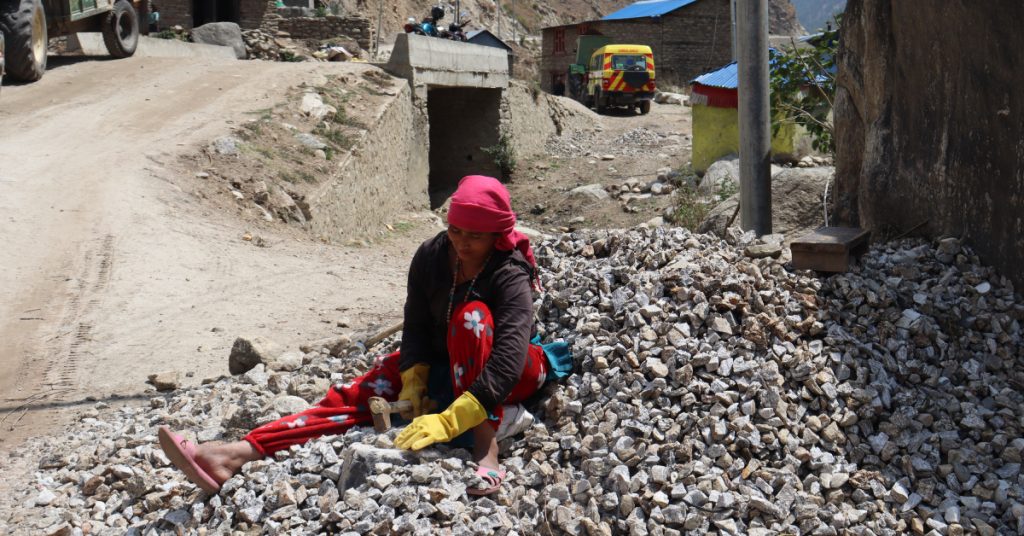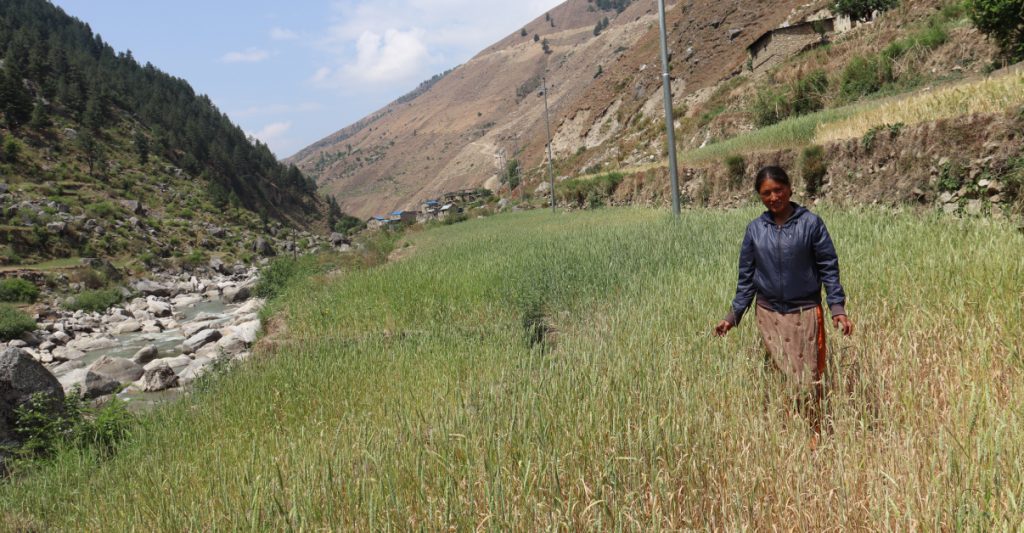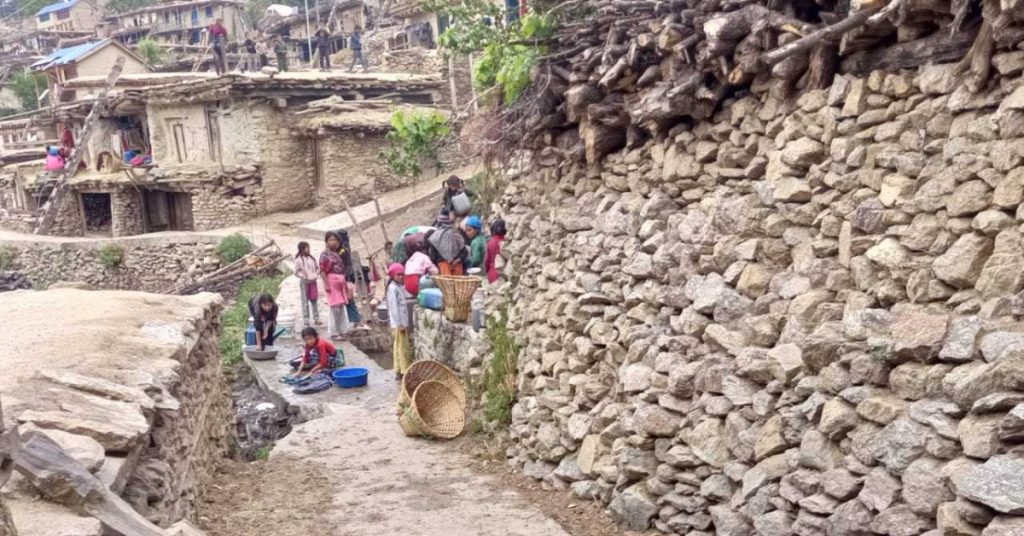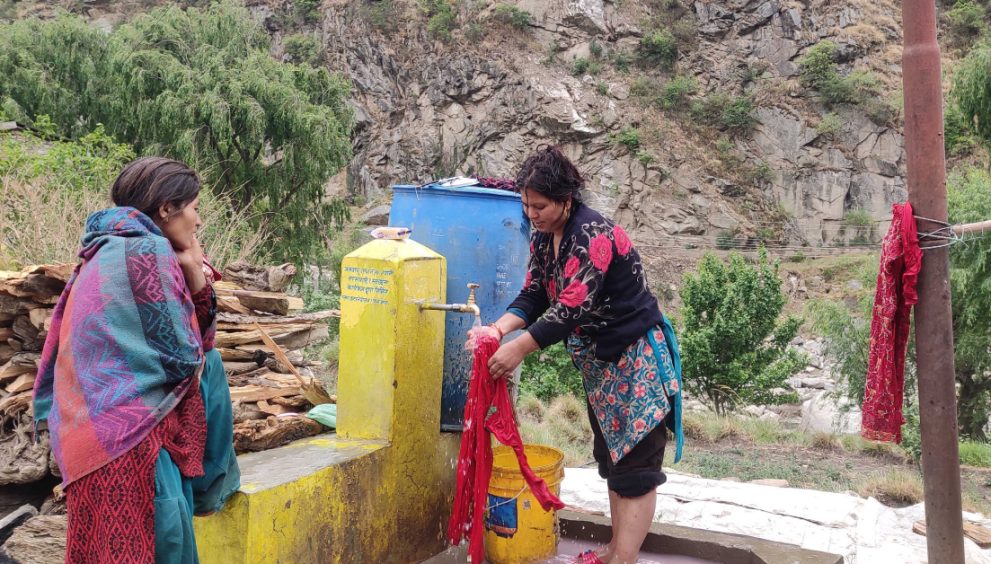Lack of enough water in Nepal’s Himalayan district Jumla, females have been suffering problems in their mensuration time.
Dudha Sahi, a 28-year-old resident of Hima Rural Municipality-2 in Bagbazar of Jumla district. She expresses concern about the challenges she faces during her menstruation cycle. “I fear my period may not arrive,” she says. “Due to insufficient water for bathing and washing clothes, this time becomes particularly difficult for me.”
Jumla is a High Himalayan district of Nepal, Over the past decade, residents of Jumla have faced worsening water scarcity compared to previous years.
According to a survey (2021), the Jumla district had 19,291 households, among them 15,441 having access to drinking water through taps. However, in reality, government record shows that people have not received water from these taps. While taps exist, water is not available.

Rara is another village in the Tila Rural Municipality-1. There are only four taps for 205 households, and they can barely get a jar of water in an entire day. “In the village, the taps are available, but the villagers cannot get water from them,” said Buddiman Rawut, a social worker from the district. “As a result, females face problems due to water scarcity and hygiene issues during menstruation.”
Nanda Prasad Chaulagain, Chairman of the Tato Pani Rural Municipality mentioned water scarcity is greater in Tatopani, Tila, and Hima Rural Municipality than in the other three municipalities. “The three, Municipalities had been facing water problems for a long time however the drought is accelerating problem than previous.”
Climate Change Impact
According to the “Vulnerability and Risk Assessment and Identification Report” by the Ministry of Forest and Environment, “climate change impacts such as drought, unusual rainfall, and other climatic hazards are more severe in Karnali Province than in other parts of the country.”
A study conducted in the Karnali region shows that the effects of climate change and population increase are altering the local hydrological cycle, making water less available at times. A decrease in rain causes droughts, leading to a reduction in raw water supplies, and reduced river flow.
On the other hand, an increase in rainfall and severe weather causes flooding, pollution of wells, inaccessibility of water sources, flooding of latrines, damage to infrastructure, landslides around water sources, sedimentation, and turbidity.
An increase in temperature causes heatwaves, damaging infrastructure. Moreover, an increase in pathogens in water raises the risk of diseases.
Springs are the major source of water in the mid-hill region of Nepal. Despite being so important for meeting local needs, studies show a steady decline in discharge from springs—around 30 percent over the past 30 years. Additionally, rising temperatures in the Himalayan region have severe implications for downstream water availability in both the short and long term.
Manohara Khadka, Country Representative of the International Water Management Institute (IWMI) Nepal, said that women’s rights to hygiene and water access have been neglected for too long. “It is an important issue for women; this issue should not be overlooked,” she said. “The government must address it. The effort is not enough.”
Some places in the Jumla district have begun to address the problem of climate-induced hazards with support from international organizations and local-level government. However, it has not covered the entire district’s issues.
Baghbazar village in Hima Rural Municipality-7 has 22 households, and the villagers have been struggling to get fresh water for a long time. Bikram Bahadur Sahi (Chairperson of ward-7, Hima Rural Municipality) mentioned that 22 taps have been installed for each household in Baghbazar village with the support of Plan International and the Rural Municipality. “After installing the taps, it became easier for the people of Baghbazar to get drinking water. Before, they depended on the pond, and the water was not fresh,” he said. “The water spring is six kilometers away from Baghbazar, and droughts have affected the water supply.”
Sahi also mentioned that his municipality has seven wards and a population of 12,612. However, fresh water is not available for the entire population; only about half have easy access to water. Some places in the district have tried to make water available and manage hygiene, especially targeting women and girls.
Parekha Raj Khatri, the headmaster of the Malika Higher Secondary School in Sinja Rural Municipality-2, Jumla, said they have managed water and hygiene, especially targeting girls. “On one hand, there is water scarcity; on the other hand, during the winter, it is very difficult for girls to use cold water during menstruation,” he added. “So, we have provided hot water from solar panels supported by Plan International.”
Dipendra Samanta, Jumla District Coordinator of Plan International, said that Plan International has implemented a climate resilience and adaptation program in the Jumla district. “We could not include all regions,” he added. “We are limited to some areas of three municipalities. In my experience, the problem is intensifying.”

Increasing Temperature
Temperature rise is a global problem; however, it is more pronounced in Nepal’s Himalayan districts than in others. According to the Department of Hydrology and Meteorology, this Jumla district’s temperature is increasing by 0.086 C per year. Meanwhile, Jumla’s temperature has increased by 1.72 C in the last 20 years. Ngamindra Dahal, a climate expert, said that this is a serious issue. “It impacts biodiversity, water, nature, and everything,” he said. “We have to focus on adaptation because we don’t have any other option.”
Experts express concern that increasing climate crises create difficulty in targeting and achieving sustainable goals. “We have to focus on water because water is the most important resource for human survival after oxygen,” Dr. Manohara Khadka, Nepal Representative of the International Water Management Institute, said. “Climate change affects water, so the government and other stakeholders should implement programs focused on water.”
The target of the current 15th periodic plan states that 99% of the population will benefit from basic drinking water services by the end of the financial year 2024/2025. Similarly, the goal is to increase access to high-medium level drinking water to 40% of the population. However, by the financial year 2018/2019, data showed that less than 25% of the population had access to high and medium-level drinking water.
According to UNICEF, 18 million people in Nepal do not have access to proper sanitation facilities, and 3.5 million do not have access to basic drinking water facilities. The water quality and distribution system is poor. Among all water sources, 71% of the water used by the entire population and 91% of the water used by poor communities have been found to contain E. coli bacteria.
20% of government schools do not have access to improved water and sanitation facilities. Another 19% do not have separate toilets and menstrual hygiene facilities for men and women. The 2021 report published by the Ministry of Forest and Environment regarding the risk and assessment of the drinking water and sanitation sector has shown that the risks in this sector will increase due to climatic disasters, droughts, and abnormal rains.

The report notes that climate change can affect water availability and quality in various ways. The mid-hill region of Nepal is the main source of water springs. However, due to extreme drought, the source water has dried up by 30% in winter, according to the report.
A study conducted in the Karnali region has shown that the effects of climate change and population growth are affecting the hydrological cycle and reducing the availability of water when needed. “Lack of rainfall leads to drought, reducing raw water supplies, decreasing river flow, increasing pollution in rivers, and compromising water hygiene,” the report states. “Increased rainfall and severe weather lead to flooding, well pollution, and reduced access to water sources.”
In a survey on climate change perception conducted by the Central Statistics Department, 74.29% of households in the country said there has been a change in their water source. Additionally, 84.47% of households said there is a decrease in the amount of underground water. Similarly, 79.64% of households in urban areas and 68.12% of households in rural areas said that water quality has decreased. Moreover, 74.56% of households in the hilly areas said that surface water is about to dry up completely.
Mukesh Pokhrel is a Climate Journalist based in Kathmandu.


